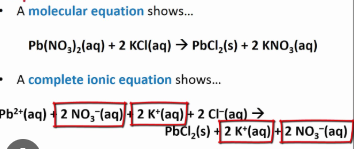Chapter 9 Classifying Chemical Reactions
1/24
There's no tags or description
Looks like no tags are added yet.
Name | Mastery | Learn | Test | Matching | Spaced |
|---|
No study sessions yet.
25 Terms
What is a reactant in a chemical reaction?
A substance that undergoes change during a chemical reaction.
What does a coefficient represent in a chemical equation?
A numerical value placed in front of a chemical formula to indicate the number of molecules or moles of that substance involved in the reaction.
What is a product in a chemical reaction?
A substance that is formed as a result of a chemical reaction.
What is a chemical equation?
A symbolic representation of a chemical reaction showing the reactants on the left side and the products on the right side, separated by an arrow.
Define a synthesis reaction.
A type of chemical reaction in which two or more reactants combine to form a single product.
What is a precipitate?
A solid that forms and settles out of a liquid mixture during a chemical reaction.
Describe a replacement reaction.
A chemical reaction in which one element replaces another in a compound or two elements in different compounds trade places.
What characterizes a decomposition reaction?
A reaction in which one compound breaks down into two or more simpler substances.
What is a solute?
A substance that is dissolved in a solution.
What is a solvent?
The component of a solution that is present in the largest amount and dissolves the solute.
Define a spectator ion.
An ion that exists in the same form on both the reactant and product sides of a chemical equation and does not participate in the reaction.
What is a complete ionic equation?
An equation that shows all of the ions present in a reaction as they are in solution.

What is an aqueous solution?
A solution in which water is the solvent.
Define a combustion reaction.
A chemical reaction that occurs when a substance combines with oxygen, producing heat and light, typically involving a hydrocarbon.
What is the difference between a skeleton equation and a chemical equation?
A skeleton equation shows compounds using their chemical formulas without coefficients, while a chemical equation includes coefficients to indicate actual quantities.
Why do we use symbols in chemical equations?
Symbols represent elements and compounds involved in a reaction, providing a concise and universal way to convey information about chemical reactions.
What results are attributable to each type of chemical reaction?
Synthesis results in a single product, decomposition yields simpler substances, single replacement produces one new compound and one element, double replacement exchanges ions between compounds, and combustion produces carbon dioxide and water.
How do dissolved substances exist in aqueous solutions?
Dissolved substances break apart into ions or molecules and disperse uniformly throughout the water.
What kinds of byproducts can chemical reactions produce?
Chemical reactions can produce gases, solids, and other compounds depending on the reactants and conditions of the reaction.
Give an example of a synthesis reaction.
A + B → AB.
Give an example of a decomposition reaction.
AB → A + B.
Give an example of a single replacement reaction.
A + BC → AC + B.
Give an example of a double replacement reaction.
AB + CD → AD + CB.
Give an example of a combustion reaction.
C_xH_y + O₂ → CO₂ + H₂O.
What kinds of byproducts can chemical reactions produce?
Chemical reactions can produce various byproducts such as gases (e.g., carbon dioxide in fermentation), solids (e.g., precipitate in double replacement reactions), and liquids (e.g., water in combustion reactions), depending on the reactants and reaction conditions.